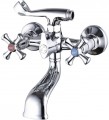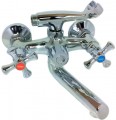Shape
—
Straight. Spout that have straight or almost straight shape and directed almost horizontally (other arrangements are highlighted in a separate paragraph — see “At right angle”). Generally, such a spout combines simplicity, practicality, and versatility. In particular, it can be of any length, and can also be rotary (see “Spout”), while being inexpensive to manufacture. Nowadays, straight spouts are extremely popular, and in almost all types of taps (see “Suitable for”). The exception is perhaps the kitchen application: this form is inconvenient for washing dishes by itself and leaves less space for dishes in the sink than other shapes (for example, angled or gooseneck spouts).
—
Gooseneck. Taps with a spout in the shape of an arc, usually semicircular and rather steep. This design is most popular in kitchen taps, as it provides the necessary space for washing large dishes. Many models with such a spout are designed for washbasins — they also use a vertical installation, for which the arc is very convenient. And gooseneck bath taps are most often original premium models installed directly on the side of the bath (also horizontally).
—
L-shaped. Spout in the shape of the letter “L” — with a vertical base and a horizontal “crossbar” extending from it. Thanks to this shape, the spout can be positioned at a sufficiently high height, which is especially conveni
...ent when used in the kitchen or with a washbasin. Most of the L-shaped models refer to these specialization options (see “Suitable for”). According to the type of the tap (see the corresponding list), they are usually single-lever, while the joystick is located on the side; however, there are other options — both in the location of the joystick, and in the type of control.
— U-shaped. Spouts of this category resemble L-shaped models (see the relevant paragraph), in which the end of the spout is noticeably bent downwards. This gives them an original shape, as well as some resemblance to gooseneck models. U-shaped spouts are typically taller and are intended for use in kitchens or washbasins. At the same time, they are not as popular as the mentioned L-shaped ones, and even more so the gooseneck ones. In particular, because of the higher cost with no obvious practical advantages (although this form may well be optimal in terms of design).
— S-shaped. A variant that is predominantly found in bath models (including bath and washbasin solutions) as well as in some kitchen taps. The spout in this arrangement has the shape of the letter “S”, laid “on its side”. This design is well suited for wall-mounted models, where the spout outlet must be placed noticeably below the tap itself.
— At right angle. A straight spout located at a right angle relative to the tap body — directed from the base of the body up or down. This shape is especially suitable for washbasins and kitchens, and it is mainly found in taps of those specializations (see “Suitable for”). Most models with a similar spout have a fairly modern appearance, thanks to that they fit well into modern, high-tech interiors, etc.
— Curved at an angle. A spout that leans upward from the base of the tap and curves slightly downward at the end. The shape is in many ways reminiscent of the “at right angle” option, but it has its own characteristics. Firstly, such a spout can be made somewhat longer, which is convenient for kitchen use: the outlet is at a sufficiently high height and there is enough space under it to wash even large dishes without any problems. Most of the models in this category are just made for the kitchen. Secondly, for some users, this form is preferable from an aesthetic point of view (although, of course, this is a matter of personal taste). These spouts look more “cheap” compared to the products of the “at right angle” form factor and are extremely rare among top plumbing brands.
— Vertical jet. This type of spout is found among bidet taps. It involves vertical spraying of a water jet for taking a hygienic shower after visiting the toilet. The mortise vertical spray module is installed separately from the tap. Usually, the design also assumes a water return valve.
— Connected to overflow. Taps with a spout in the form of a flexible hose that connects to the overflow of the bathtub, and the water is poured through it. Thanks to such taps, minimalism is ensured in the appearance of the bathtub, which is caused by the absence of a classic spout. In addition, there is no need to make extra holes in the side of the bathtub to install the tap.Jet depth
Distance from the fixing point (for vertically mounted taps) or from the centre of the mounting hole (for horizontally mounted taps) to the middle of the spout. It is a characteristic that determines the "reach zone" of the tap.
Material
—
Brass. Alloy based on copper and zinc; at a relatively low price, it has good strength and corrosion resistance, due to which it has become widespread.
— Silumin. An alloy based on a combination of aluminium and silicon; it has good hardness and oxidation resistance, but it is rather brittle, and therefore it is used mainly in inexpensive models.
— Stainless steel. The most common material for inexpensive models. Steel is inexpensive and at the same time has high strength. Its disadvantage is a certain tendency to corrosion (especially with processing defects, even small ones), which practically does not affect everyday use, but can affect the durability of the tap.
— Zinc. Zinc products are similar in their main properties to the silumin products described above: on the one hand, they are inexpensive, on the other hand, they are quite fragile and not particularly durable. In addition, zinc is believed to be prone to corrosion, which can eventually degrade the properties of the water coming from such a tap and make this material unsuitable for kitchen use. Therefore, zinc bodies are not common, mainly among inexpensive bath and shower taps.
— Plastic. The simplest material used in the manufacture of taps. Due to its weak strength, it is not durable, but it does not rust. It is appropriate to use for sinks of rare use — for example, for a country house.
Tap height
The height of the tap, measured from its base or lowest point to the highest point of the spout. The height of the spout partly determines the installation possibilities — in fact, this is the minimum vertical free space that is required for the tap. In addition, in models with horizontal installation (see "Type of installation"), the spout height is related to the jet height (see below).

